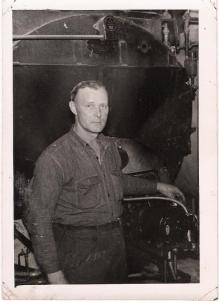

The first class annual was apparently that for the class of 1929, and was called "The Acorn." Gene Paskiewicz, Godwin class of 1978, interviewed Charles Saur in around 1978, and was told that the name Acorn was chosen because of all of the oaks, hence acorns, around the school in the late 1920s yet. This makes sense from the perspective of that time. A look at the one room schoolhouse in June, 1900, shows that there were many oaks on the property that time. The name "Acorn" was used in 1929, 1930, and 1931. There were then no class annuals for five years, and the name "Acorn" was apparently forgotten, including the reason the first three were even called that. Between 1937 and 1940 there was a great deal of construction on the school property, including the ten acres sold to Godwin in 1935 by Frank Rackett. By the end of 1940 almost all of the oak trees had been cut down, and replaced with everything from a library to football and baseball fields, tennis courts and new additions to the high school building. The rural feel of the area was fading fast, and that usually means most of the trees disappear. In the early 1950s yet there were some large oak trees in front of Frank Rackett's house, but those were removed when Division Avenue was widened. In 2004 the only original oaks are those in front of the former library building, which all apparently date from at least 1900.
The classes of 1927 and 1928 apparently did not have class annuals, even while they were the first two classes to have a twelve year program. Godwin only went to the tenth grade up to the 1924/1925 school year.
During the Great Depression years of 1932 to 1936 there were no annuals at all. Usually a copy of the "Godwin News," the school newspaper, would be devoted to the senior class, and serve as the class annual. In 1943 there was no annual. It was decided that it would be more patriotic to save the paper. In hindsight, it's too bad that an annual was not made up, and printed after the war ended. In reality, paper is one thing that was never in short supply during the war, but few could have known that at the time.
As of 2006, all annuals for the years 1929 to 1963 have been scanned, and are presented in section "C." Many were made available for the "Godwin's Past" web site by Edna ( Carpenter ) Keyes, class of 1934. Her father, Henry Carpenter, was the chief engineer at Godwin, and given a class annual each year. ( Note that his wife Catherine was president of the P.T.A. ) These still exist, are in perfect condition, and were used for scanning for many of the years between 1929 and 1949. Wayne Pierce, class of 1960, provided information about the annual collection, and paved the way for their use. Lee (Tanner) Collins, class of 1941 made a number of annuals from the late 1930s and early 1940s available. In all cases, those making the annual for a class year available for use on this web site are noted in section "C", in the area for that class year.
Left click on the image below for a larger version.
Henry Carpenter, in about 1940.
Material from annuals over the years mirrors to some extent the fashions and commerce of the school and the surrounding area, and to some extent recount the makeup of the businesses in the area over the years. Annuals are an ongoing record of fashions, fascinations, faculty, and other events and objects of interest to each class over the years. It is not that expensive - as of the year 2000 - to store information online and make it available via the Internet, so it remains a hope that one day all of the annuals can be made available online. But this web site will only go as far as the annual for the class of 1963.

Clearly intended to both show support for Godwin and help pay for the production of class annuals, the ad pages now form a chronology of businesses in the area, some long gone, some new, and some around for a long time. Some were hangouts for Godwin students, some simply places to shop, part of the strip malls of their day. Around and before 1950 or so many of the shopping areas were better defined - Home Acres, Godwin Heights, Burton Heights, Southlawn. Today many of these names mean nothing, and some have decidedly gone down hill. For those that remember when Burton Heights and other areas were thriving, family areas, the annual ad pages include businesses many Godwin students once found familiar.
Ad material can be found in the annuals, and scattered around the web site as appropriate.

Left click on the image below for a larger version.
The circumstances of superintendent Chambers' leaving are not completely clear. It seems to have been some kind of dissatisfaction on the part of the school board.
In any case, the era of long serving board members and superintendents was over. Charles Saur served for something like 25 years. Board members Rackett, Doxtator, and Bartels served from between 25 and 40 years. But with their retirement would come a quick succession of other superintendents and board members. Chambers stayed for three years, followed by Roscoe Miner, who stayed seven years, to be replaced by Cornelius Bruggink. Board members came and went at a dizzying pace.

The airport was first named Daniel Waters Cassard Field.
In 1949 the runway was extended to 44th st. In 1954 the runway was extended
to the south of 44th st. A system of gates and signals closed
44th st when bigger jets would come in, 44th st was used for part of
the runway. In June of 1960 the new airport was approved.
Left click on the images below for larger versions.

|
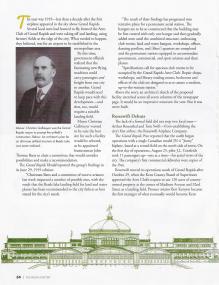
|

|
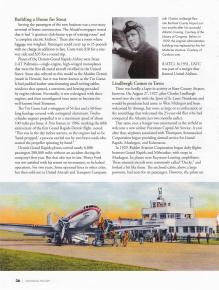
|
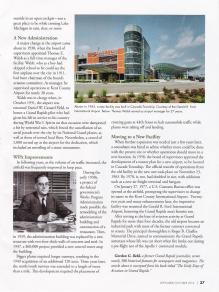
|
Like so many developments in technology, it was unappreciated in 1919 just how much air travel would grow, and that the airplanes of the future would need longer runways that could be accommodated by the land available. The land was already somewhat hemmed in by housing developments in the 1920s, and in the 1940s it was apparent that providing long enough runways for modern passenger jets was a losing battle. The scheme for closing off 44th street when a plane needed to take off or land was clearly impractical, and spelled the end of any hopes of further expansion. The topology of the land going east was not suitable for expanding in that direction, but in any case there was a still somewhat active railroad track on the east side of the airport, the NY Central tracks from Grand Rapids to Jackson, and residential areas further east.
A 1907 Kent County Street Atlas shows the area comprising the
Kent County Agricultural Industrial
Society Fair Grounds.
Grand Rapids always had a fair ground, but as the city grew, the
land devoted to it moved continually south, for the last time to the
area shown in the map.
Like every city across the eastern US at the time, the fair grounds
contained a one mile horse race track. Horse racing was apparently a major
form of entertainment, perhaps replaced somewhat later by things like
baseball and auto racing.
Left click on the images below for larger versions.
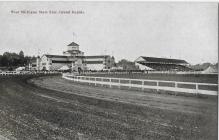
|
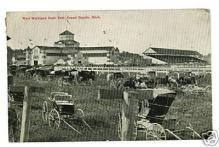
|
The fair grounds became an aviation field in July 7, 1919, when packages began
to be flown in from Chicago to local merchants by Fish Hassell, in a Curtis
biplane. In May of 1925, the county board of supervisors signed a five year contract
with the Grand Rapids Aero Club. This led to the establishment of the first
all-passenger scheduled airline in the US, which began service on July 31, 1926.
Called the Stout Air Service, a scheduled service was started between
Grand Rapids and Detroit.
What follows is an ecclectic collection of photos of people and things around the old Grand Rapids Airport,
mostly in an around the 1920's. Dates and details supplied where known. Jalene Doxtator, class of 1947, worked
at the airport on 32nd Street, and mentioned that there were many archieve photos in the offices. Sadly, unless
someone stole them, none have survived.
Note that Ford bought an existing airplane manufacturing company, and started producing Ford plane. Perhaps the
most famous was the Ford tri-motor, a very durable airplane. William Bushnell Stout designed the plane, which was
first produced in 1925, at a company that Stout started,
and produced until 1933. Only 199 were produced, of which 12 still existed in year 2012,
so the plane's reputation far exceeds its actual number. It was a very good and rugged plane. The three motors
probably reflect the lower reliability of aircraft engines at the time. Hitler traveled in a German version of the
plane, which also had a feature that ejected the passenger compartment if and emergency arose. Parachutes would
then bring the compartment more or less safely to the ground.
Left click on the images below for larger versions.
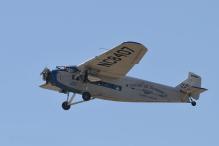
Restored Tri Motor |
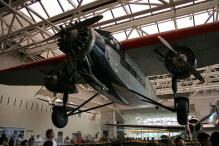
Smithsonian Museum display |

Tri Motor interior. |
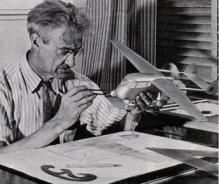
Willaim Bushnell Stout - 1943 Designed Ford Tri-Motor |
Left click on the images below for larger versions.

Circa 1926 |
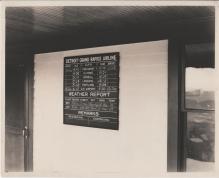
|
Left click on the images below for larger versions.
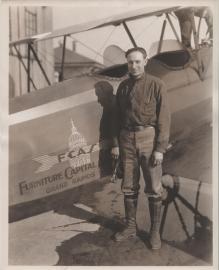
1929 |
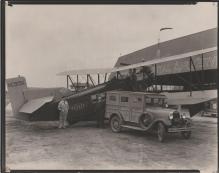
|
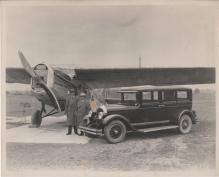
|
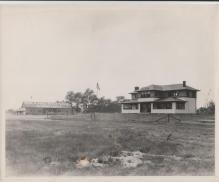
1926 - fair ground club house at right. |
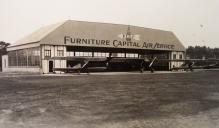
|

|
Left click on either image below for a larger version.
Material provided for scanning by John Kamstra, a local collector.
The exact meaning of the "First Flight" envelopes above is unclear at present.
Aviation was still young in 1928, regular service in Grand Rapids only started
in 1926, and the flight from NYC to Seattle might
have been a first for air mail for cities along the route, which tended to
be northern states. Perhaps the trip and things like the envelops were part
of a promotional for air mail. In any case, the envelopes were clearly
carefully signed and stamped, with collectors in mind.
Left click on the images below for larger versions.
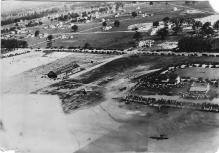
c1932 |
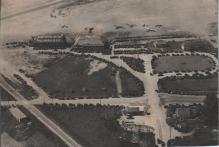
c1930 |
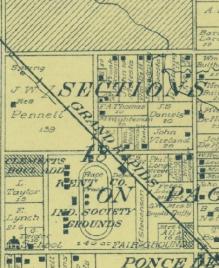
1907 |
The photographs above were provided by scanning by LeRoy Rockwell, class of 1959.
The photographs above show aerial views of the Kent County airport, in the corner of Jefferson Avenue and 32nd Street - 32nd Street was called Fairground Avenue along that stretch in 1932, and Jefferson Avenue by the airport was called Paris. 36th Street, along the southern edge of the old airport was called Allen Road. Not shown, there was a small depot by the railroad tracks, for people from Grand Rapids going to the fair grounds and horse race track. When it was removed, and whether it served the old airport in the early days, is not known at present.
If one follows the road from the building with "Grand Rapids Airport" on the roof to what is today 32nd, one sees to houses on the north side of the road. The one on the left was built in 1929 for Jay Doxtator, long time Godwin school board member. It appears that farms in the area north of 32nd Street has essentially ceased to exist, and the roads north of 32nd Street suggest those areas were already under development.
Jalene Doxtator, class of 1947, relates that the event shown in the photograph above was called an Air Fair - a blend of the old country fairs and the new airplane industry. She and her family were able to sit and watch them from their front porch, but otherwise saw the events as a nuisance, given the amount of traffic and dust produced. ( Most streets around Godwin were dirt until about 1950. )
Jalene relates that in the 1930s a PopCorn Wagon was always parked at the airport, and was owned by someone was the last name May, which might have been short for Mahanazian, or thereabouts. And the old wooden administration building sold things like ice cream cones, perhaps reflecting its past as the main building on the Kent County Fair Grounds, no doubt serving food and drink in those times.
Note the intersection of 32nd - if is called that in 1930 - and Madison. Madison is paved. 32nd is not. Looking at the cars, the photo might be a little earlier than 1930.
In the NW corner of the intersection, where Charlie's Chips now is, was a house. I suspect the yard was on the south side too, by 32nd. To the north of the house appears t obe a small business. And note the small build in front of the house, by the road.
On the NE corner appears to be a relatively new gas station, looking at the construction area and the new looking concrete. One can see a Texaco sign on the south edge of the concrete. The station is of the drive under the covered pump variety. What the little building is to the right is unclear.
There is some kind of air show going on, based
on the crowds and the cars. On the very left side,
I think I see the rail splitting. There was at one
time a stop at the old fair ground and race track.
It's possible that some kind of platform or station
would have been shown if one could see a little
further to the SE.
Left click on the images below for larger versions.
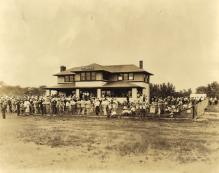
|

|
The photograph above, left, from about 1926, shows the orginal airport terminal. It was previously part of the Kent County Fair Grounds, and later replaced by the more familiar art decco terminal building of the 1930s through about 1960. The event shown might be an air show of some kind, or the dedication of passenger service.
Left click on the image below for a larger version.
Passenger service at the old airport - by Godwin - was inaugurated in 1926, so the photograph is after that, but by how much is unknown. If the plane shown is one that made runs to Milwaukee, it would take an act of faith that a single engine plane of that time would not have trouble over Lake Michigan, a potentially fatal outcome.
Left click on the image below for a larger version.
The date of the photograph above is not certain. 36th Street still runs to Eastern Avenue. The kinds of airplanes stacked up along the east most runway suggests the early 1930s, but that is just a guess. The quality of the photograph is less than desirable, but one can still pick out various features in the area at the time.
During the Great Depression of the early and mid 1930s a lot of airport infrastructure was built, as part of W.P.A. projects, which by 1941 amounted to about two million dollars. As many as 7,000 men worked on the projects, including digging gravel out of airport land, and putting a fence around the entire airport as it existed at that time. At the same time, Godwin added the library, sports fields, and a new wing on the highschool, and perhaps Rackett Pool, all W.P.A. projects. The Kohler Brothers, later to become Capital Airlines, completed a hanger, and started the first train-plane connecting flights to Milwaukee and Detroit. Perhaps train-plane meant that the depot next to the NY Central railroad track, there since at least 1907, brought passengers in from Grand Rapids, and other towns southeast of Grand Rapids, to connect with air flight. This was of course the eventual doom of railroad passenger service... About the same time, Jack Byrne's Michigan Air Express began service between Grand Rapids and Detroit, Cadillac, Charlevoix, and Petoskey.
In about 1935 the DC-3 was introduced, and was literally the wide body aircraft of it's day. Able to easily take off from the runways of the 1930s airport, they were a common sight, and flew right over Godwin school, as seen in this photograph from around 1938.
A recreational shelter house used during the W.P.A. construction eventually became the airport restaurant. It was initially run by Bob Van Artsen, who later became the airport manager for the Kalamazoo airport. The restaurant had a meeting facility in the basement for business gatherings. At some point the structure burned. Since the airport had moved, there seemed to be no motivation to rebuild, despite the lack of eating establishments in that area even today.
The structure to the right of the building with "Grand Rapids Airport" on the roof was the first airport terminal, and was previously the fairground clubhouse building when the land was still the Kent County fairground. Another W.P.A. project in the early 1930s was the the construction of the art deco terminal building that so many Godwin students remember, with its revolving searchlight on the top, which gave a strange air of confidence to the surrounding area at night.
Left click on the images below for larger versions.

|
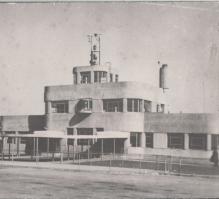
|
The years of WWII saw vastly expanded activity at the airport, including temporary barracks, as part of the Home Guard.
In 1949, Lake Central started service at the airport, and in 1953, North Central, a.k.a.the blue goose.
Left click on the image below for a larger version.
A North Central airplane, in an undated photo.
For the next ten years the future of the airport was studied. It was clear it had become too hemmed in by development in the surrounding area to expand much more, or to support adjunct businesses. By 1960 the battle was lost, and a new airport built. The old airport land never really found its stride.
Sadly, the photo does not quite show 28th Street. One can see the railroad tracks almost merging with Division Avenue, but misses by perhaps a block. Just south of where the railroad tracks crossed 32nd there was once a small depot that served the county fair grounds. Whether it served the airport too, and when it was removed, are not known at present.
There was a "High Speed" gas station in the northeast corner of Madison Avenue and 32nd Street in the 1930s already. Ron Doxtator, class of 1937, worked at the station in the mid 1930s.
There are colorful stories about Bill Lear coming to Grand Rapids in the 1930s, and being a major booster for an enlarged airport. One involves a large old tree on the southeast corner of Eastern Avenue and 36th Street. The airport needed the tree removed because it was at the end of one of the runways. The owner refused. One rainy night a group of men came around and cut the tree down. Though no one was ever caught, a death bed confession by one of them made it clear that it was Bill Lear and some others. That kind of swashbuckling activity was more common in the 1930s and 1940s when people of substantial means, including Howard Hughes, were media regulars for their exploits with aircraft and record setting. Different laws, and a more crowded world, make it unlikely that people like that could function today.
The first Lear plant was in a building at 110 Ionia, which exists today.
Left click on the image below for a larger version.
The photograph above is from about 1964. A large hanger was built at the old Grand Rapids airport around 1964, and is shown below.
Left click on the image below for a larger version.
The hanger was later demolished to make room for more Lear buildings on Eastern Avenue.
Material above made available by LeRoy Rockwell, class of 1959.
During WWII the airport had its own post office, and was likely a busy place.
A June 26, 1943, note of appreciation for the Grand Rapids airport, containing some amusing facts and figures about the airport at that time. What became of the Skyfarer project is not clear.
Left click on the images below for larger versions.
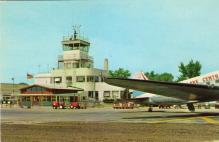
|
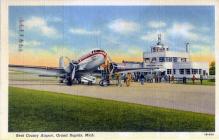
|

|

|

|
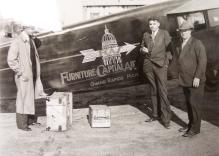
|

|
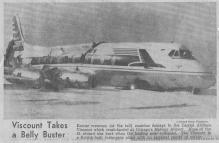
|
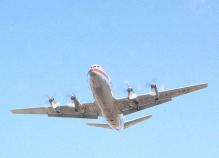
|
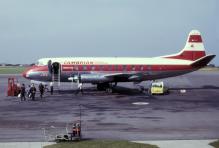
|
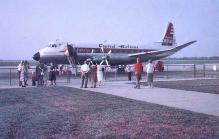
|
Use of the postcard was provided by LeRoy Rockwell, class of 1959.
The early Viscounts had a nasty tendency to explode, although the later models are still in use
in year 2013 in a few countries. They were the closest the old airport ever got to civilian jet
travel. Military jets did use the old airport, in particular the Canberra - B-57, an early British
military jet.
The view of the old airport in the postcard images above probably dates from
the mid 1950s - the one car in the image that could be used to give
some idea of the date cannot be seen very well. Lake Central disappeared.
On July 1, 1968, Lake Central merged with Allegheny Airlines, and the
combined system was called Allegheny Airlines. The DC-3 was last used in 1967.
Allegheny Airlines later became US Airways.
The photograph below shows the airport in about June, 1957. The shadow on the runway is probably that of a B-57, which was often at Lear at the time for various tests. It likely took the photograph.
Left click on the image below for a larger version.
Jalene Doxtator relates that there was a wood propeller factory on the south side of 32nd Street, just west of the railroad tracks, owned by Flottorp. It was sold to the father of Jim Taylor, class of 1946. The building was eventually taken over by the airport, and used for county offices. Jim Taylor and his brother eventually moved to Florida to make and sell boat propellers.
By 1947, when Jalene's future husband, Wilbert Beattie, started working at the airport, the dominant air carrier was Pennsylvania Central Airlines.
Left click on the images below for larger versions.
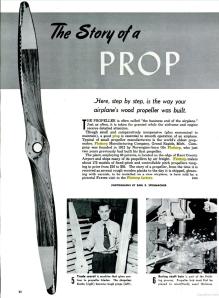
|
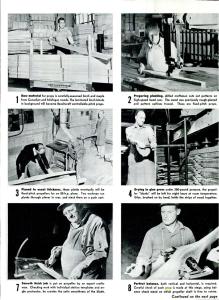
|
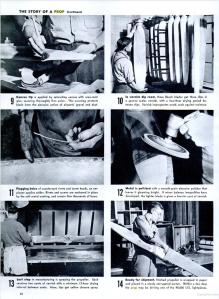
|

While "Detroit" still means automobiles to many, it doesn't mean it in 2005 in the same way that it meant it in, say, the 1950s. For generations of Godwin students, up to perhaps 1980 yet, Michigan, was dominated by the auto industry, right down to the local level. The General Motors stamping plant on the southwest corner of 36th and Buchanan Avenue, completed in 1936, ( there's reason to believe that Charles Saur was instrumental in getting the plant located in the area ) employed generations of Godwin students, and paid off many a mortgage and college education. Division Avenue, between 28th and about 52nd, contained seemingly endless new and used car lots, with large strings of light blazing away at night, reflecting a time was electricity was cheap. Along with them were a similarly endless number of gas stations and garages of various kinds. Most gas stations had garages staffed with knowledgeable mechanics.
Godwin rose to the challenge of supplying skilled labor for the local auto industry. The Quonset Hut (developed in 1941 in anticipation of war time needs, in Quonset Point, RI ) located north of the library was obtained in 1944 from the National Youth Administration, and ready for use in September, 1944. It contained shops for woodworking, metal arts, including welding, machining, and cutting, and an engine overhaul area, where three or so engines were endlessly torn down and rebuilt. In all of this one again sees the hand of Charles Saur, together with businessmen in the area, who all saw this as a good way to train future laborers for local industry of all kinds. It's said that the GM plant on 36th Street supplied some of the machinery for the shop, at Charles Saur's behest.
In the classroom, students took mechanical drawing, which taught the importance of careful, neat work. Math and science courses were no doubt a help to those that wanted to later do design work, or perhaps get training in tool and die making.
Once prepared, students had little trouble finding jobs in any of the automotive settings mentioned above. Many students of the time lived and breathed cars, and even Saturday mechanics could do the routine work required to keep a car running well. It was not unusual for a student to quit school at age 16, which tended to be the 10th grade, and go to work for GM, and retire 40 or 45 years later with a pension. By year 2005 the situation had decidedly changed.

A necessary evil, countless garages kept cars and other vehicles running all through the 20th century, as they still do, albeit with rather fewer visits necessary, in the 21st century. Cars were simpler in the early and mid 1900s, but much less reliable than the cars of 2005, where things like materials, filters, and oil are superior to what was previously available. So many people spent their working years repairing cars and otherwise keeping them running well.
Leon Smith, class of 1953, says his father owned a number of garages around Grand Rapids over the years. The one below, located at 234 Market Avenue, in downtown Grand Rapids, dates from about 1930.
Left click on the images below for larger versions.

1928 |
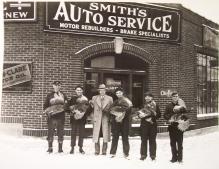
1928 - Thanksgiving turkeys for employees. |
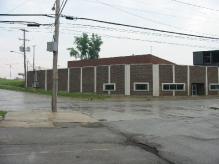
|

|
Lee Smith, class of 1953, provided the photographs. Market Street runs left and right. Williams Street runs along the left side of the building.
Clearly the Grand Rapids area where Smith's Auto Service was located in the 1930s has changed dramatically. Little around the building has survived, and the building itself houses an adult book store in 2005.
A couple of unusual photographs show the interior of Smith's Auto Service.

|

|
Lee Smith, class of 1953, provided the photographs.
In year 2005 insurance companies would surely have fits to see how the cars in the photographs are propped up. People in the 1930s had a more practical view of life, and were probably mostly dimly aware of what a lawyer is. They did get the job done.

Left click on the images below for larger versions.

|

